Email popups remain one of the most effective ways to grow your email list, with the best examples achieving conversion rates of 25-35%. But not all popups are created equal. The difference between a 3% popup and a 35% popup often comes down to design, timing, messaging, and the story you tell.
In this guide, we'll analyze 15 real email popup examples from successful Shopify brands, complete with conversion rates, revenue impact, and the specific strategies that made them work.
TL;DR
- High-converting popups combine compelling value propositions, strategic timing, and seamless user experience
- Educational popups (15-25% conversion) build trust by providing value upfront before asking for emails
- Interactive/gamified popups (30-40% conversion) break through banner blindness with engaging experiences
- Mobile optimization is critical—60% of traffic is mobile, requiring specific design considerations like 44x44 pixel buttons
- Exit-intent popups (20-30% conversion) represent your last chance to convert departing visitors
What Makes an Email Popup Convert
Before diving into examples, it's crucial to understand the core elements that separate high-performing popups from generic ones.
The best email popups combine compelling value propositions, strategic timing, and seamless user experience. They don't just ask for an email—they start a conversation, tell a story, or solve an immediate problem.
The most successful popups share five key characteristics:
- Clear value proposition - Whether it's a discount, exclusive content, or education, users need to understand what they're getting
- Strategic timing and triggering - Exit-intent, scroll depth (50-70%), or time-based triggers (30-60 seconds) based on engagement signals
- Mobile optimization - Responsive design with minimum 44x44 pixel buttons and simplified layouts
- Brand alignment - Visual hierarchy and messaging that feels authentic to your brand voice
- Friction reduction - Auto-applied discounts, minimal form fields, and streamlined user experience
Struggling with low popup performance? Alia's AI-powered smart triggering automatically optimizes display timing based on user behavior—brands like MiHIGH saw their opt-in rates jump from 6% to 18% just by letting AI handle the timing.
High-Converting Discount Popup Examples
Discount popups remain the most popular approach for ecommerce brands, but execution makes all the difference. The most successful discount popups go beyond generic "10% off" offers to create engaging, interactive experiences that build brand connection while capturing emails.
Example 1: Nakie's Multi-Screen Educational Popup (35% Conversion Rate)
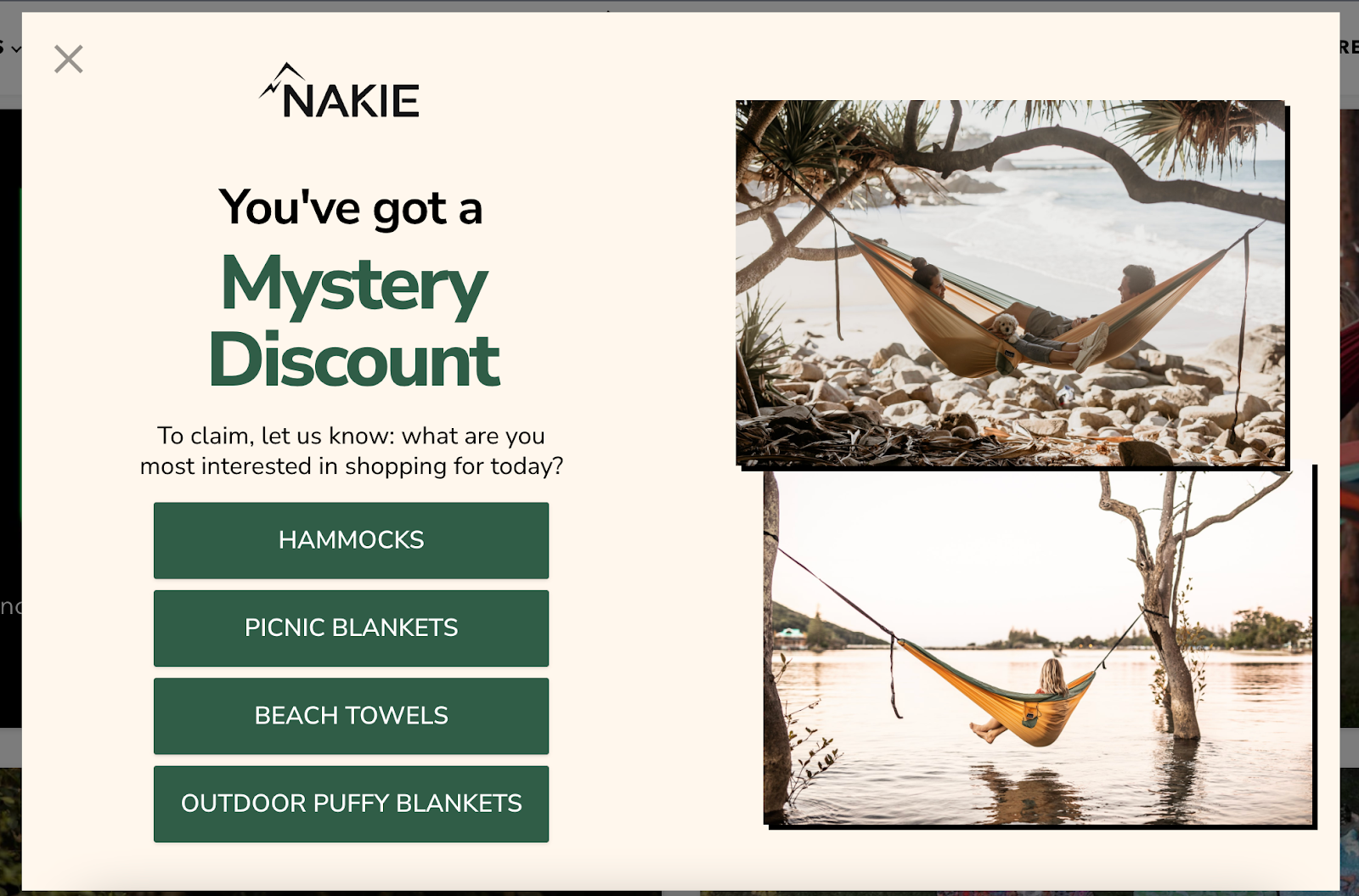
Nakie, the Australian outdoor gear brand behind the world's first hammock made from recycled plastic bottles, transformed their email capture strategy with a multi-screen popup approach.
Instead of the typical static "10% off" offer, they created a dynamic experience that educated visitors about their sustainability mission while collecting valuable segmentation data.
The Design Approach:
- Multi-screen popup flow with progressive disclosure
- Interest-based questions (beach hammock, picnic blanket, backpack) for email segmentation
- Sustainability education integrated throughout the experience
- Auto-applied discount codes at checkout to eliminate friction
Results:
- Email opt-in rate increased from 5-6% to an average of 28%, peaking at 35%
- 24% purchase rate after signup through Alia
- $5.8M+ in attributed sales from Alia-driven email flows
- Best performing week: just under $900K in attributed revenue
Example 2: Essence Vault's Gender-Targeted Popup (33% Email, 26% SMS)
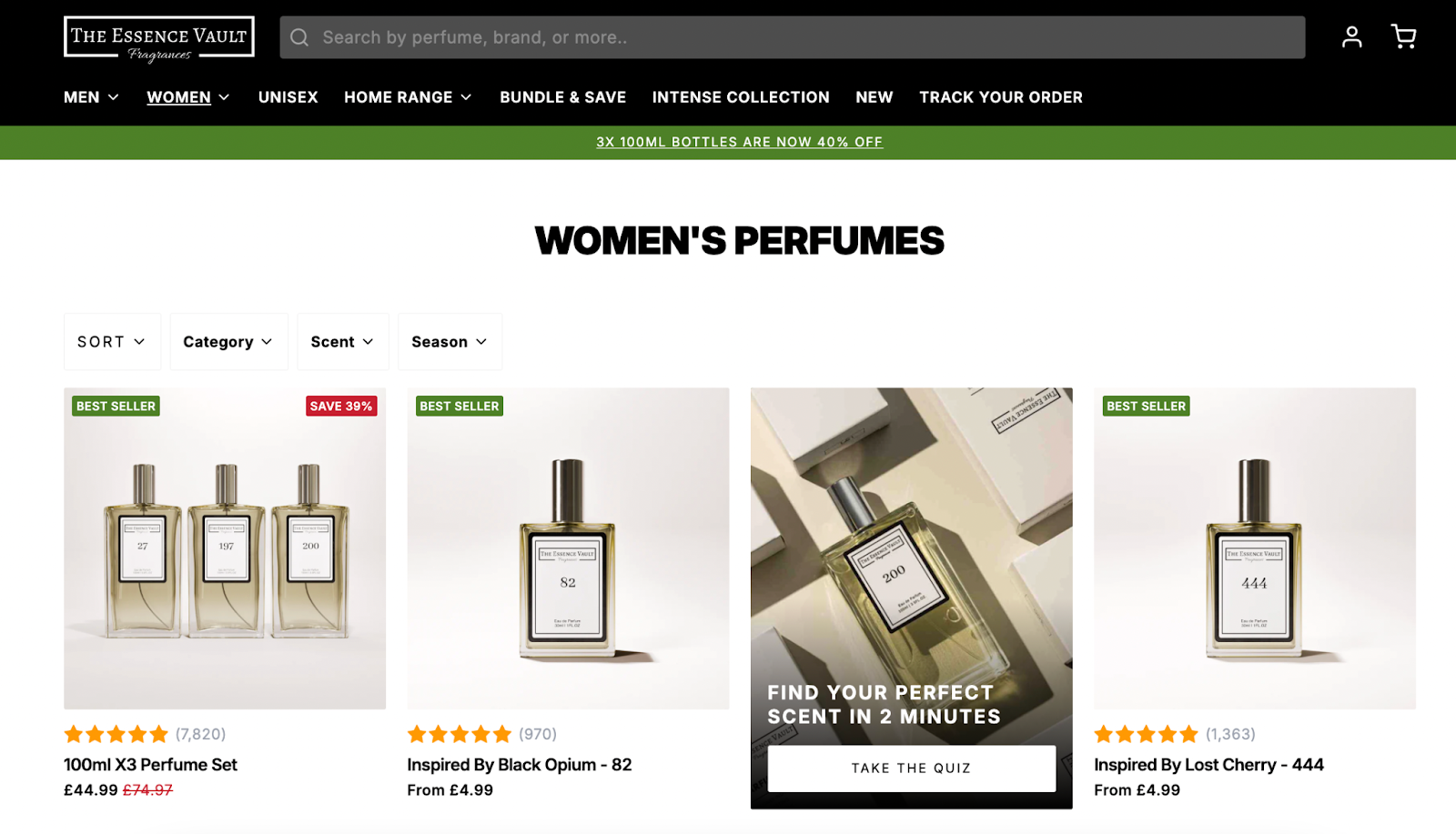
Essence Vault, a UK-based fragrance brand, revolutionized their lead capture by focusing on zero-party data collection. Their popup strategy centered on understanding customer intent through gender preferences, enabling highly targeted follow-up campaigns.
The Design Approach:
- Visually rich popups tailored to traffic source and behavior
- Gender preference collection for advanced segmentation
- Dual opt-in strategy capturing both email and SMS simultaneously
- Always-on approach during high-traffic periods like BFCM
Results:
- Email sign-up rate: 33% (increased from 11%)
- SMS sign-up rate: 26% (increased from 4.2%)
- 360,000 emails and 285,000 phone numbers collected in one month
- 200,000 emails and 160,000 SMS collected during BFCM (9 days)
Example 3: Gardencup's Mystery Discount Experience (22.4% Conversion)
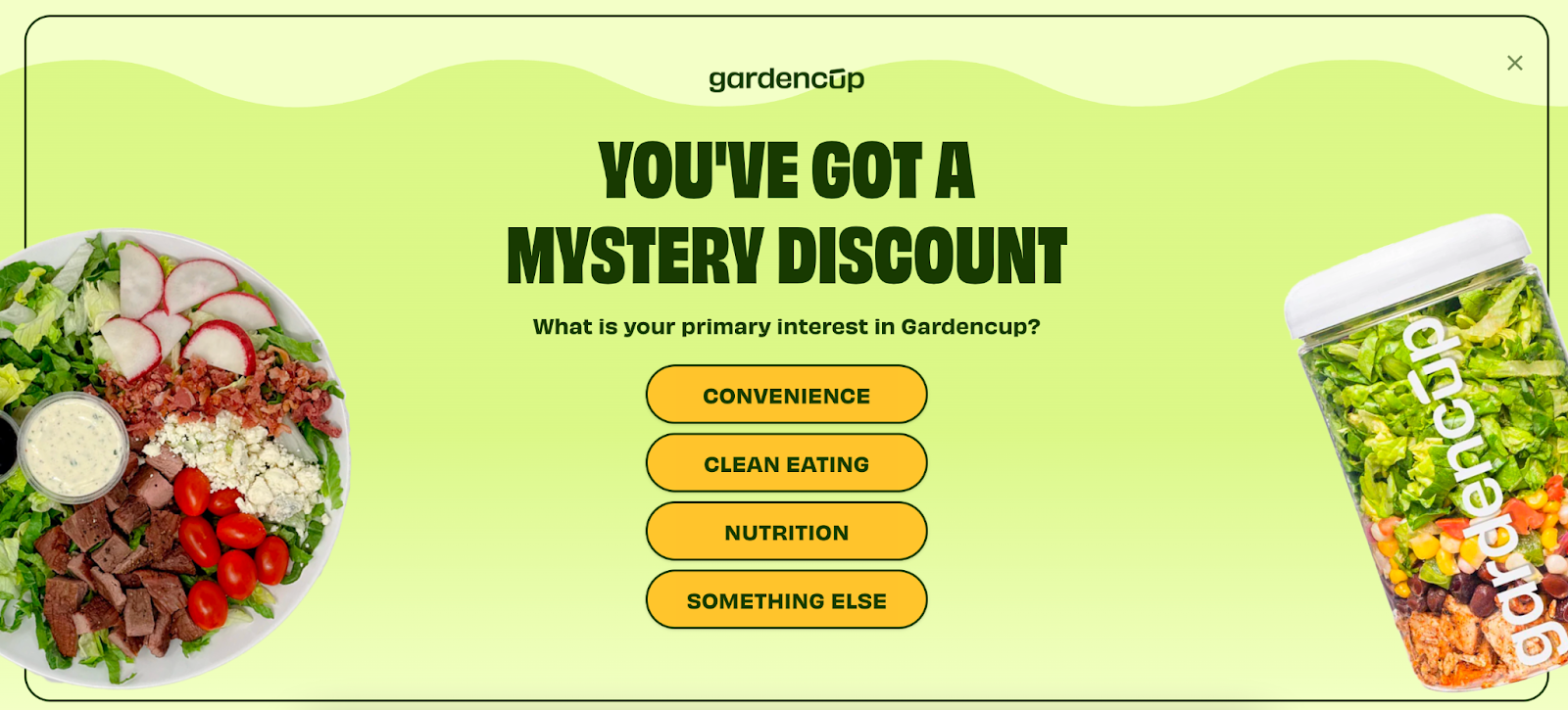
Gardencup, a US-based meal subscription service, replaced generic static popups with an engaging "mystery discount" experience. This gamification approach combined the excitement of unknown rewards with practical zero-party data collection.
The Strategy:
- "Mystery discount" gamification to create anticipation
- Mobile-optimized design with image removal for better mobile performance
- Quiz-style logic integration for interest-based segmentation
- Personalized Welcome Flows powered by collected intent data
Results:
- 124% increase in net new email subscribers
- 177% increase in net new SMS subscribers
- 22.4% email opt-in rate, 15.8% SMS opt-in rate
- 76% uplift in Welcome Flow revenue
Example 4: Firebelly Tea's Three-Lesson Educational Journey (36% Purchase Rate)

Firebelly Tea, a premium loose leaf tea brand focused on sustainability, created an innovative three-step educational journey that combined learning with progressive rewards. This approach transformed casual browsers into educated, engaged customers.
The Journey Design:
- Three educational "lessons" delivered via a floating Alia button
- Progressive discount rewards (5% to 15%) for continued engagement
- Brand origin story, product value, and sustainability education
- Zero-party data collection through embedded custom questions
Results:
- 2.2x increase in email sign-ups compared to Klaviyo
- $13,000+ in incremental revenue vs. previous popup system
- Purchase rate increased from 14% to 36% after signup
Example 5: Patrick Ta Beauty's Frictionless Experience (12% Conversion)
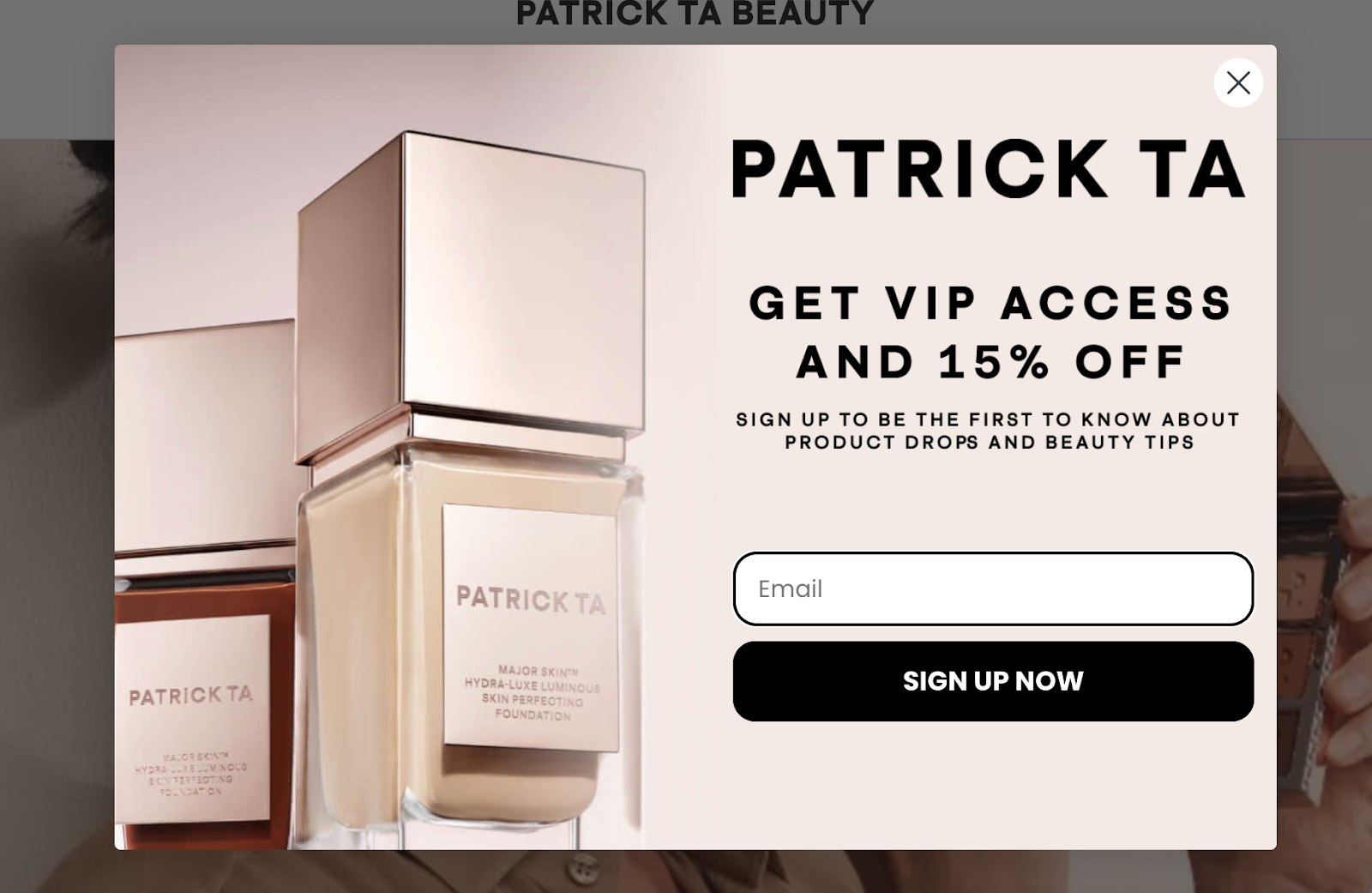
Patrick Ta Beauty, the luxury cosmetics brand by celebrity artist Patrick Ta, focused on creating a seamless, frictionless popup experience that automatically applied discount codes and tracked real-time redemptions.
The Frictionless Strategy:
- Automatic coupon application at signup to reduce friction
- Real-time discount code redemption tracking
- High-converting experiences without custom coding requirements
- Support for email agency optimization and remarketing performance
Results:
- 167% increase in email sign-ups (from 9,000 to 24,000 in one month)
- 12% average opt-in rate
- 15% purchase rate after signup
- $600,000 in revenue attributed to Alia-powered popups within 2 months
- 27% of all new orders used an Alia-generated discount code
Want to see more discount strategies that work? Check out 13 discount popup examples that actually drive sales for detailed breakdowns and templates.
Educational Popup Examples That Build Trust
Educational popups represent a growing trend among brands that need to explain complex products or build trust before asking for an email. These popups turn the traditional "discount for email" model on its head by providing value upfront, then earning the subscriber relationship.
Example 6: ZQuiet's Product Recommendation Quiz (19% Conversion)
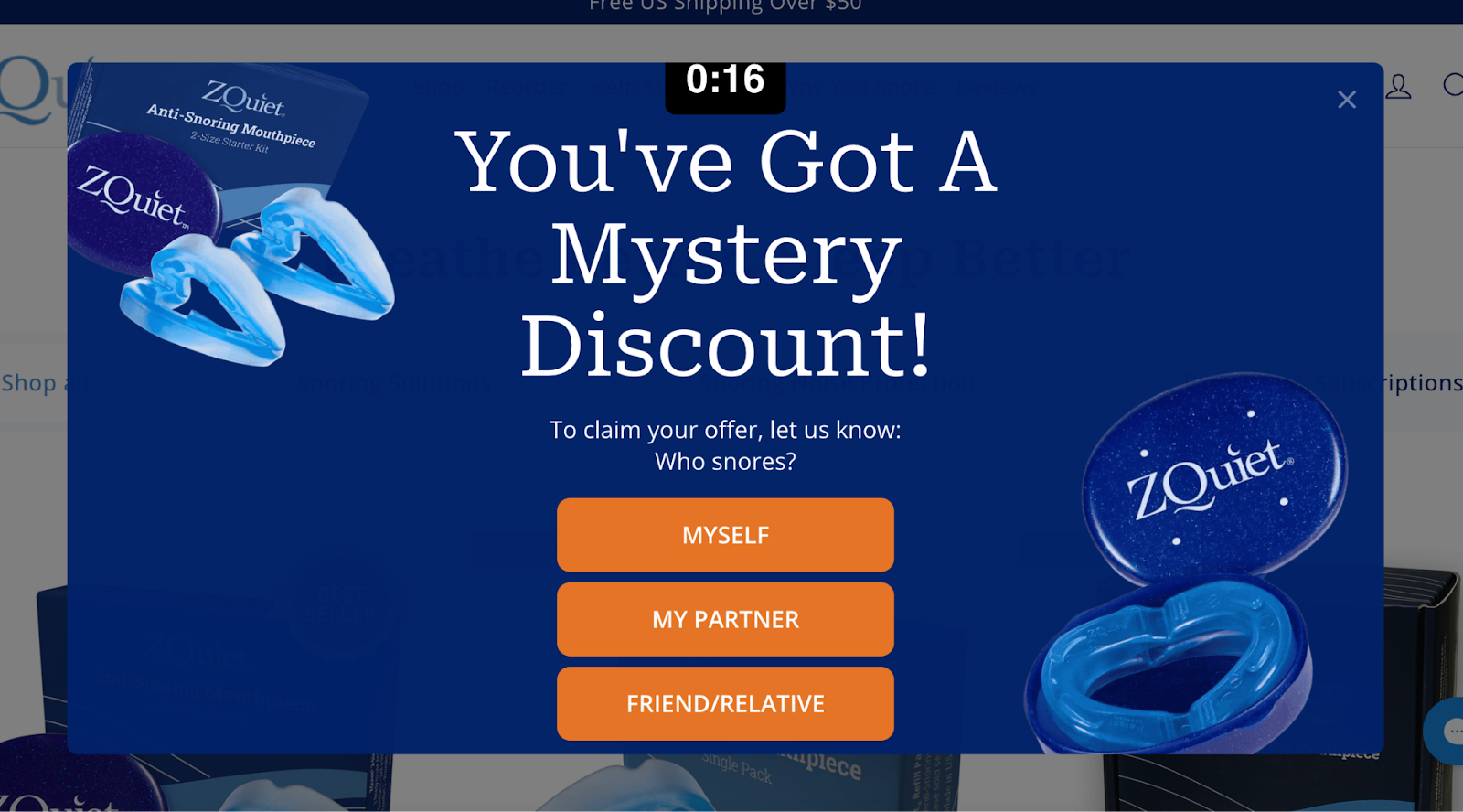
ZQuiet, a US-based sleep wellness company offering FDA-cleared anti-snoring solutions, faced the challenge of guiding customers to the right product while building trust in their medical-grade solutions.
The Educational Strategy:
- Quiz-based product recommendation flow with personalized guidance
- Educational content about anti-snoring solutions and sleep health
- Trust-building through FDA clearance messaging
- Fully managed A/B testing and optimization through Alia's team
Results:
- Email sign-up rate increased to 19% (up 660% from 2.5%)
- $120,000 in sales driven in the last 30 days
- 32% of signups converted to purchases within 30 minutes
Example 7: MiHIGH's Infrared Sauna Education (18% Conversion)
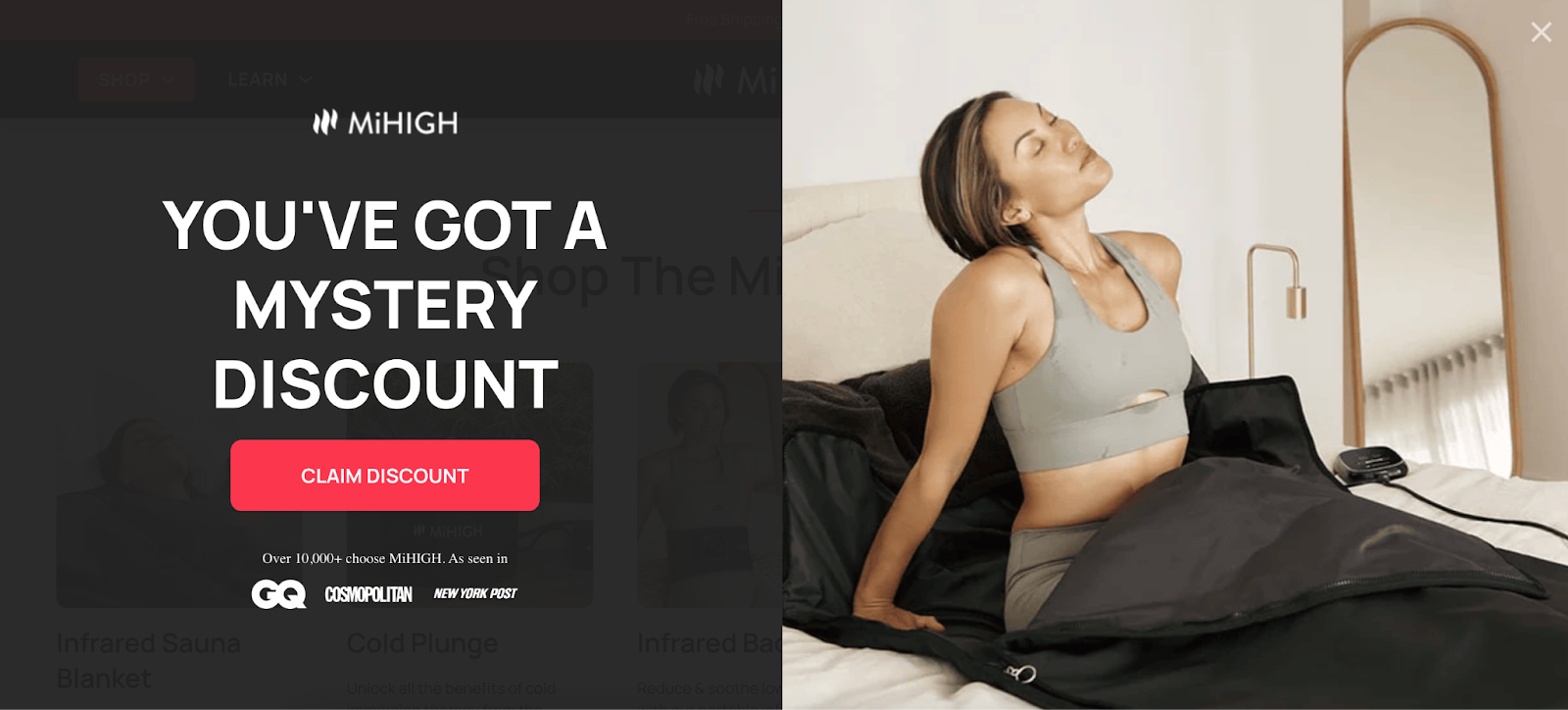
MiHIGH, a wellness brand specializing in infrared sauna blankets, needed to educate potential customers about the benefits of their innovative recovery products. Their popup strategy focused on turning product education into an engaging, conversion-friendly experience.
The Educational Approach:
- Interactive educational experiences explaining infrared sauna benefits
- Product education integrated seamlessly into the opt-in process
- Brand messaging that built trust and value pre-purchase
Results:
- 3x increase in opt-in rate (from 6% with Klaviyo to 18% with Alia)
- 5x more signups per day
- $600,000 in attributed sales over just 30 days
Example 8: Soapbox's FAQ Integration Popup (15.4% Conversion)
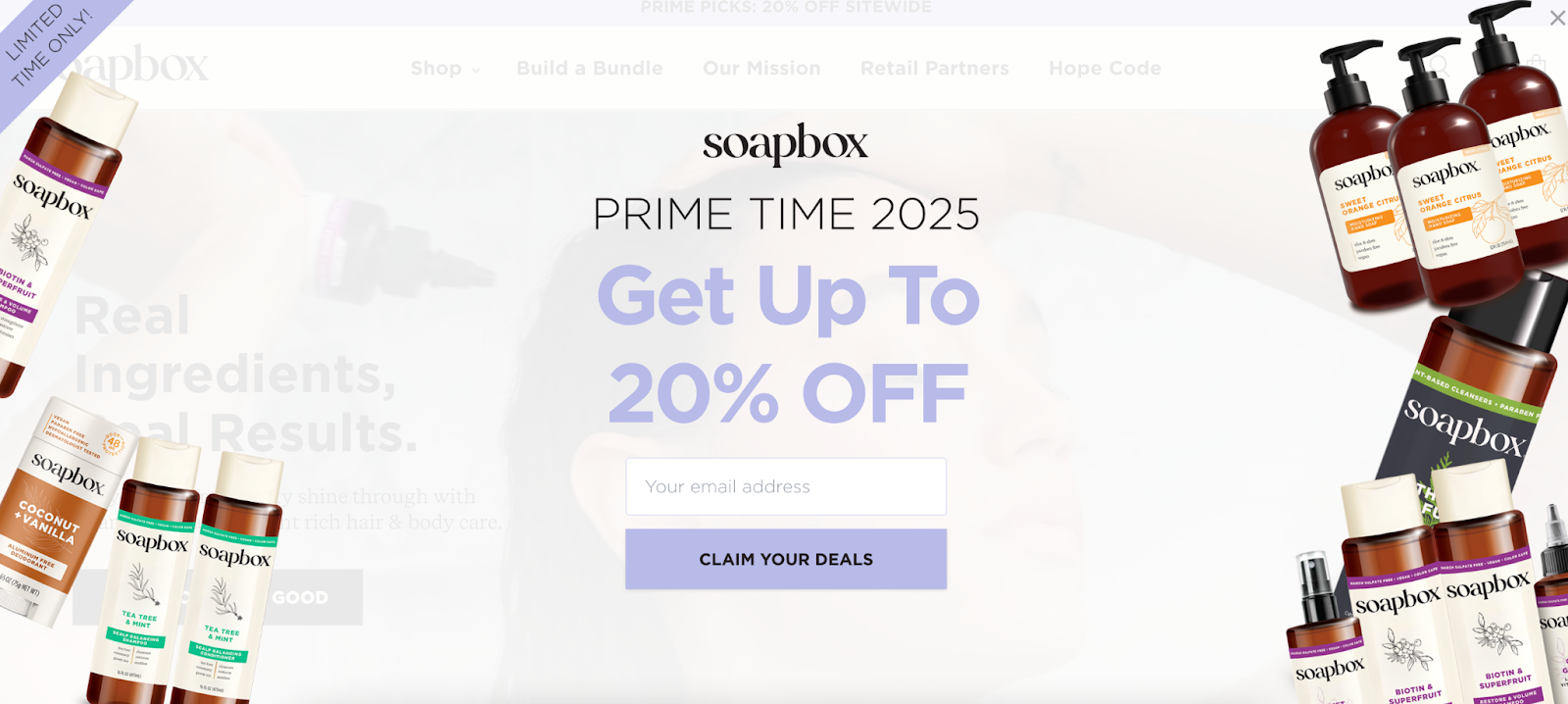
Soapbox, a personal care brand with a buy-one-donate-one soap mission, used their popup to address common customer questions while building their social impact story. This approach reduced friction by proactively answering concerns within the signup experience.
The Strategy:
- Interactive educational popups telling their social impact story
- Two-step popups combining discounts with data collection
- FAQ integration directly within popups to reduce customer friction
- Segmentation based on expressed interest for better targeting
Results:
- Email sign-up rate increased to 15.4% (up 135% from 6.5%)
- SMS sign-up rate increased to 10.1% (up 122% from 4.5%)
- 12.5% purchase rate within 30 days of signup
Example 9: JOI's Plant-Based Education Widget (15.4% Conversion)
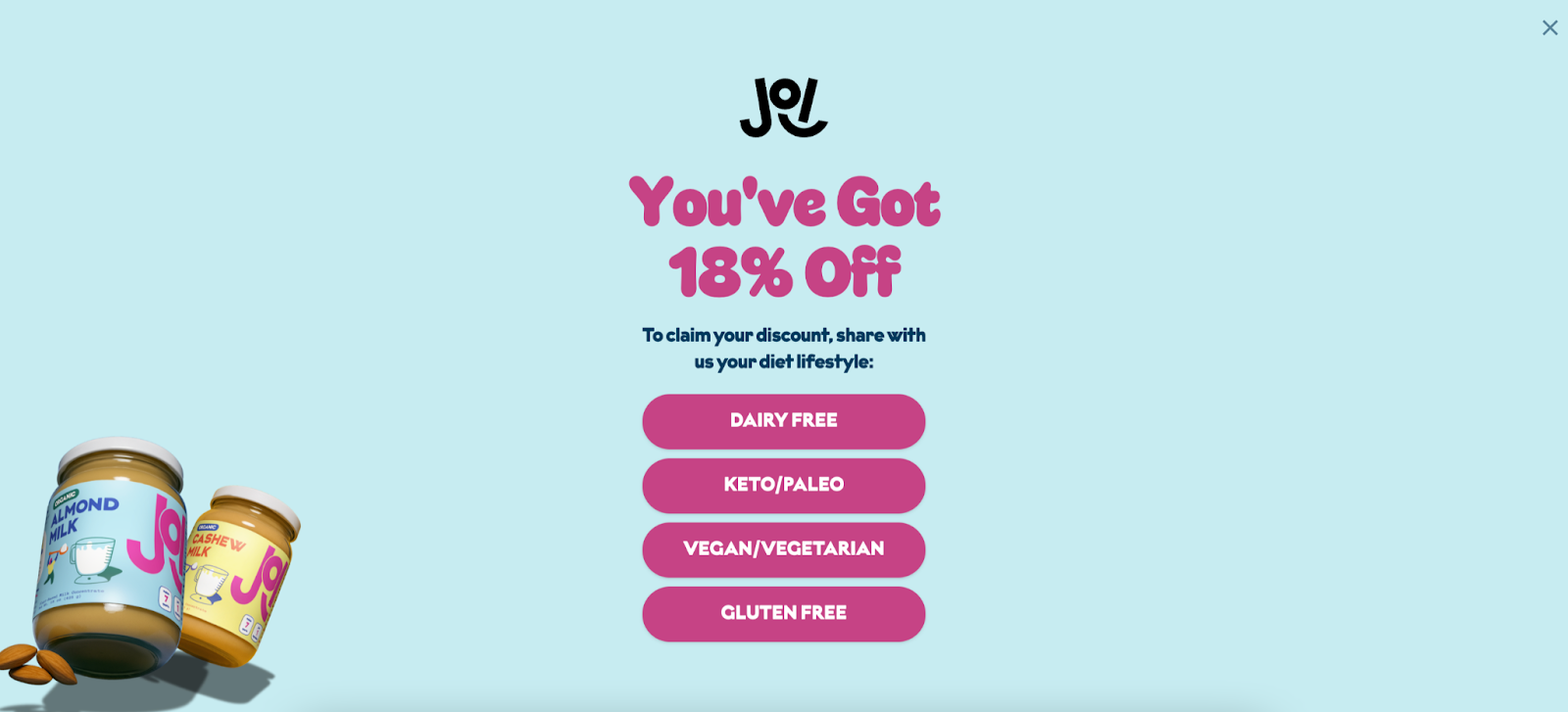
JOI, a plant-based food company specializing in clean label, non-dairy milk concentrates, needed to educate customers about their innovative products while building trust in the plant-based food category.
The Educational Widget Approach:
- Widget-style educational format for better product explanation
- Clean-label product education integrated into opt-in experience
- Easy Klaviyo integration for segmented email journeys
- Personalized marketing efforts based on captured preferences
Results:
- 15.4% email opt-in rate
- 36% increase in email sign-ups
- 21% purchase rate after signup
- 15% increase in email-driven revenue
Interactive & Gamified Popup Examples
Interactive popups break through banner blindness by requiring user engagement before revealing the offer. These examples show how gamification can dramatically improve both engagement and conversion rates when executed thoughtfully.
Example 10: Urban Smokehouse's Founder Story Popup (20% Same-Session Purchase Rate)
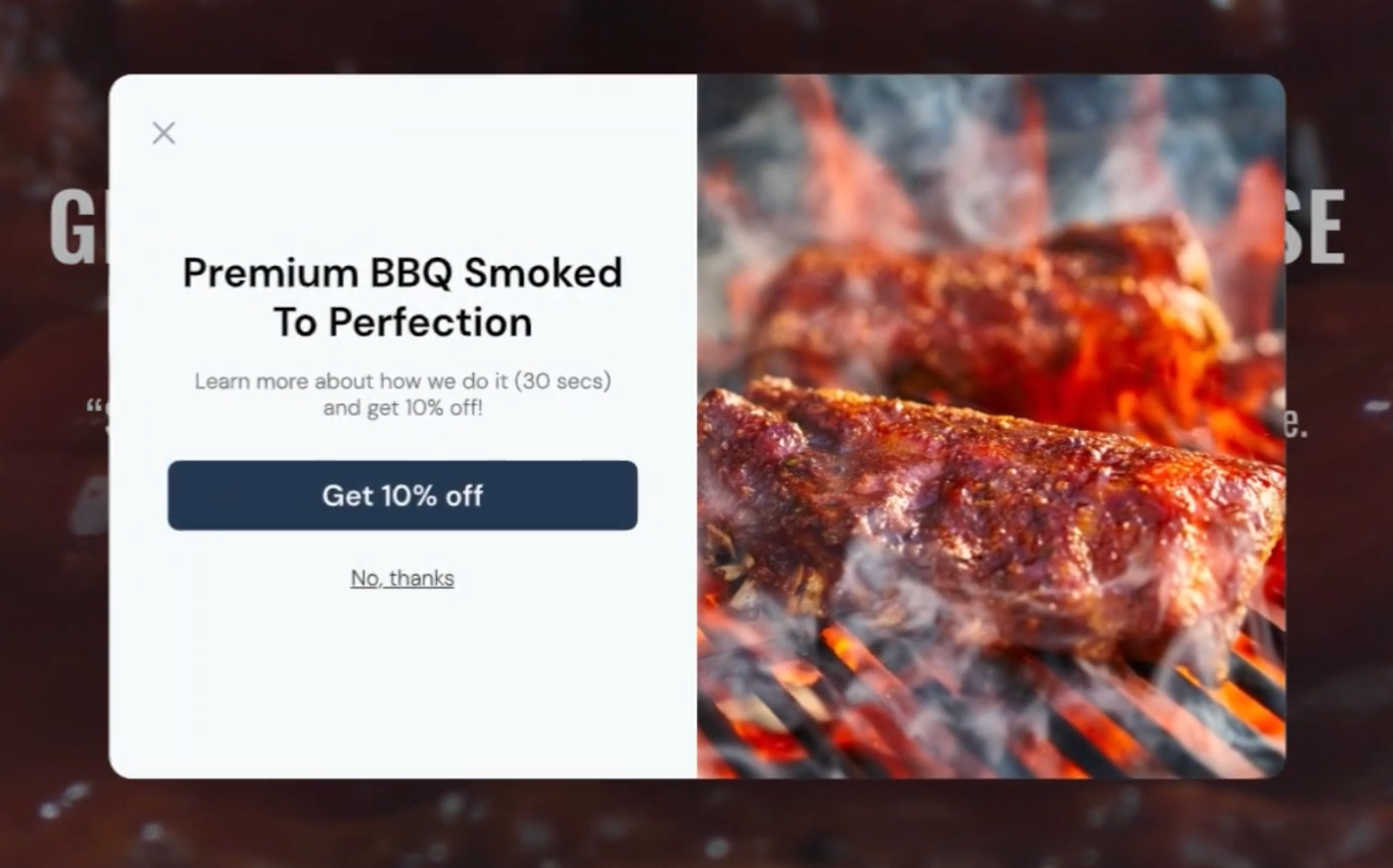
Urban Smokehouse, a DTC barbecue brand, used their founder's personal journey from finance to BBQ as the centerpiece of their popup experience. This storytelling approach created emotional connection while driving immediate conversions.
The Story-Led Approach:
- Educational, story-led flow via a floating button
- Founder's transition from finance to BBQ as the narrative arc
- Progressive discount structure (5% off after first step, up to 10% off)
- 30-minute discount expiration timer for urgency
Results:
- $100,000+ in additional monthly sales
- 9.5% popup sign-up rate (184% increase from previous 3%)
- 20% same-session purchase rate after signup
- 1/3 of monthly revenue now attributed to Alia
Example 11: MASA Chips' Gamified Health Education (29% Same-Session Purchase)
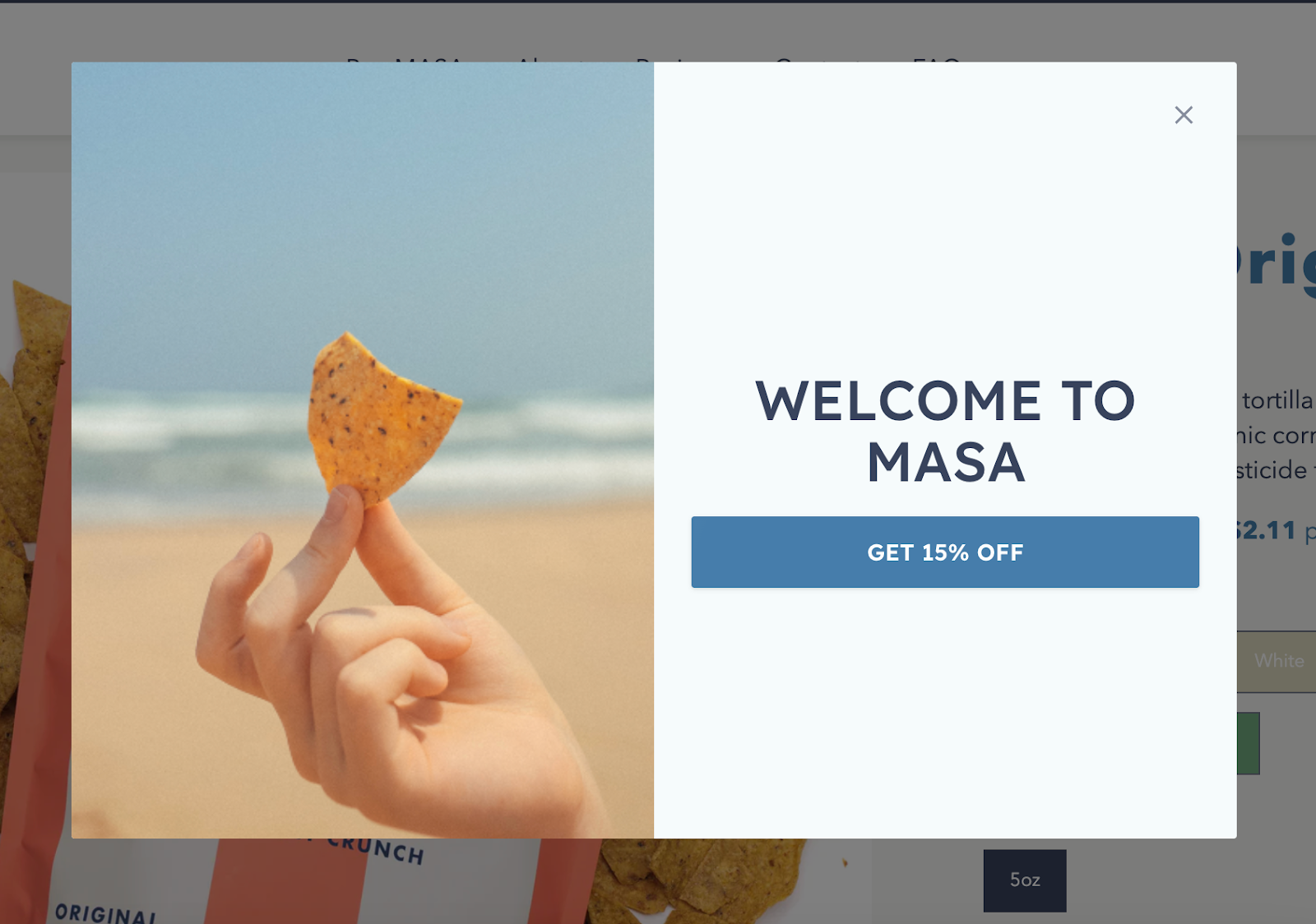
MASA Chips, by Ancient Crunch, focused on real-ingredient chips that redefine American snacking. Their gamified popup combined health education with an engaging user experience that addressed customer concerns while building brand trust.
The Gamified Strategy:
- Retained basic 10% signup flow while adding journey to unlock 20% off
- Health-first story integration through customized, gamified popup
- FAQ integration within the popup flow to reduce buyer hesitation
- Seamless onboarding with handholding and free A/B testing support
Results:
- 127% increase in popup sign-up rate
- 2.1x increase in new shopper purchases
- 46% increase in purchase rate
- 29% same-session purchase rate after signup
- 64x ROI attributed to Alia
Looking for more interactive ideas? Our guide on creating engaging popups without annoying customers shows exactly how to balance engagement with user experience.
Mobile-Optimized Popup Examples
With mobile traffic accounting for over 60% of ecommerce visits, mobile popup optimization isn't optional—it's critical. These examples show how successful brands adapt their popup strategies specifically for mobile users without sacrificing conversion performance.
Example 12: Create's Landing Page vs. Site Popup Strategy (18% Conversion)
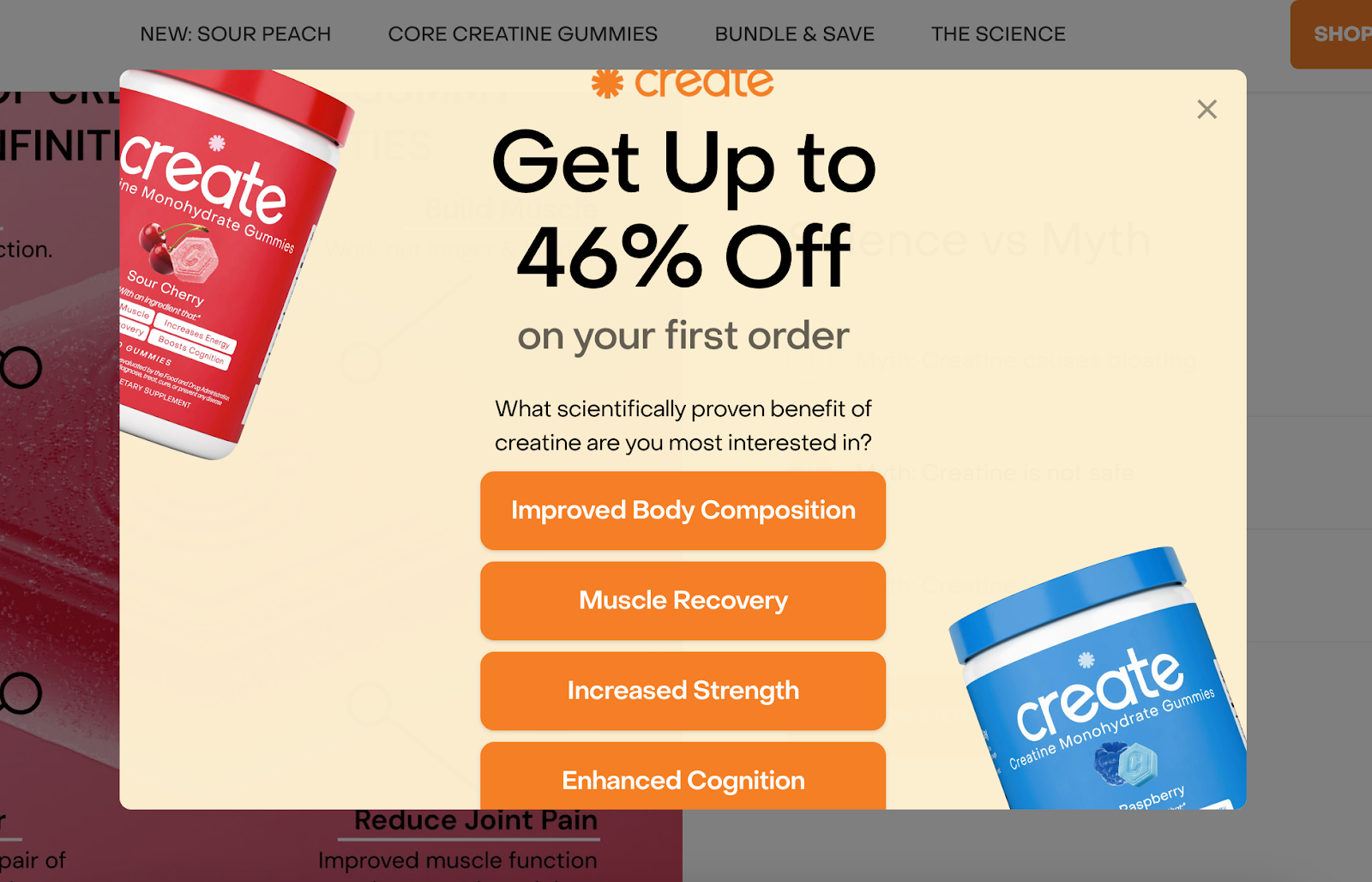
Create, a wellness brand specializing in creatine gummies, developed separate popup strategies for landing pages versus their main site. This nuanced approach recognized that mobile users arriving from ads have different intent and expectations than organic browsers.
The Strategic Approach:
- Separate popup strategies for landing pages vs. main site traffic
- Intent-based segmentation enabling precise welcome flow targeting
- Landing page popups reintroduced without negatively affecting conversion rates
- Customer-friendly popup designs requiring minimal internal effort
Mobile-Specific Optimizations:
- Simplified form fields (email only)
- Larger touch targets for mobile interaction
- Reduced visual complexity for smaller screens
- Fast-loading popup elements optimized for mobile connections
Results:
- 18% email sign-up rate (significant improvement from previous tool)
- 200% increase in sign-ups captured through optimized landing page popups
- Maintained performance metrics even with rising traffic volumes
Example 13: Bhumi's Auto-Discount Mobile Experience (18.6% Conversion)
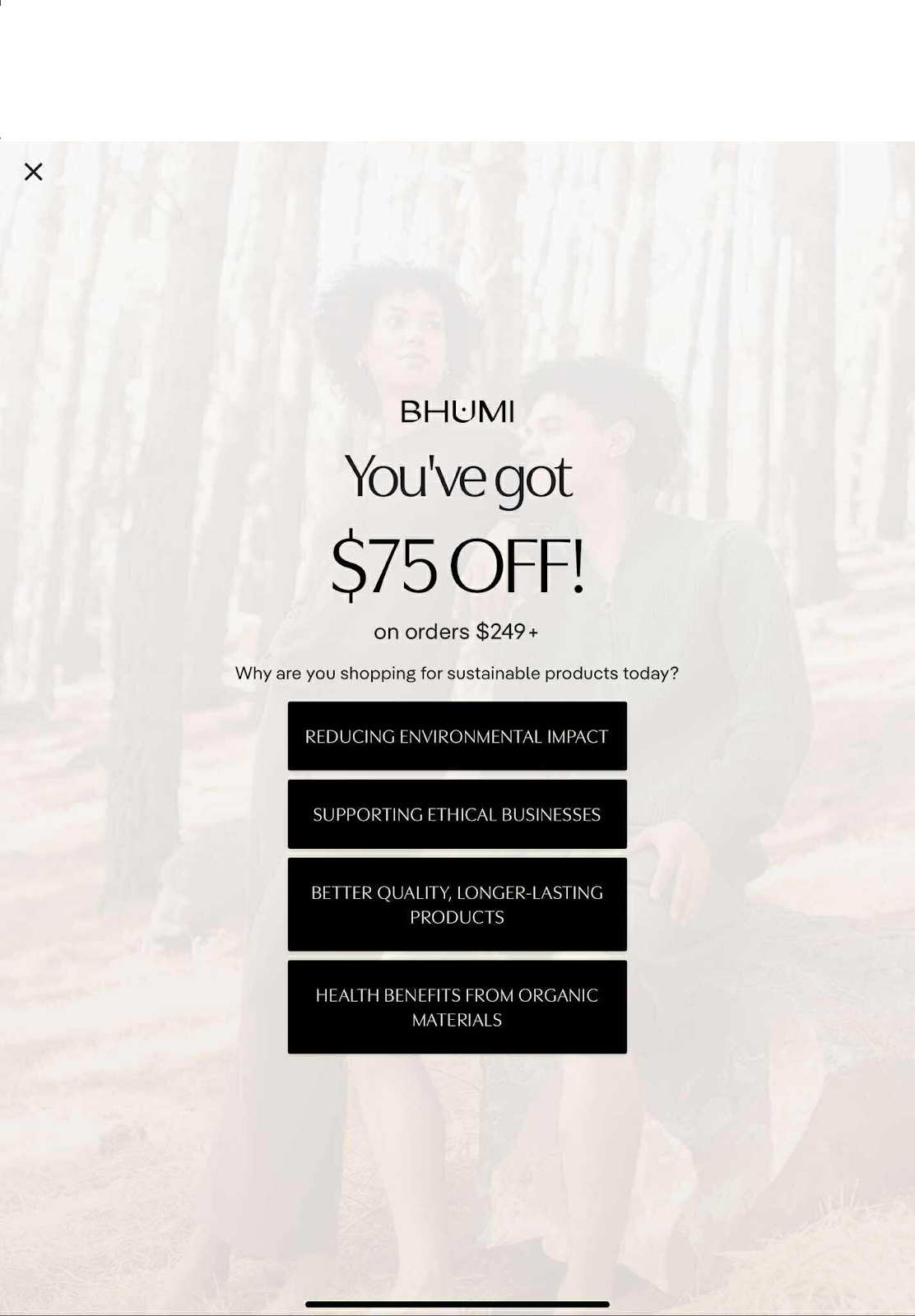
Bhumi Organic Cotton, an Australian sustainable fashion brand, recognized that mobile users often struggle with manual discount code application. Their solution focused on removing friction through auto-applied discounts.
The Mobile-First Strategy:
- Auto-applied discount codes specifically for mobile user convenience
- Sustainability storytelling adapted for mobile consumption
- Mobile-friendly visual design with clear hierarchy
- Zero-party data collection optimized for touch interactions
Results:
- 18.6% email opt-in rate (up 272% from 5% baseline)
- 12.1% SMS opt-in rate
- $300,000 in attributed sales over 30 days
- Tripled average order value among first-time customers
Exit-Intent Popup Examples
Exit-intent popups represent your last chance to convert departing visitors into subscribers. The most effective examples use urgency, exclusive offers, or compelling content to give users a reason to reconsider leaving.
Example 14: Hostage Tape's Full-Screen Exit Popup (25% Conversion)
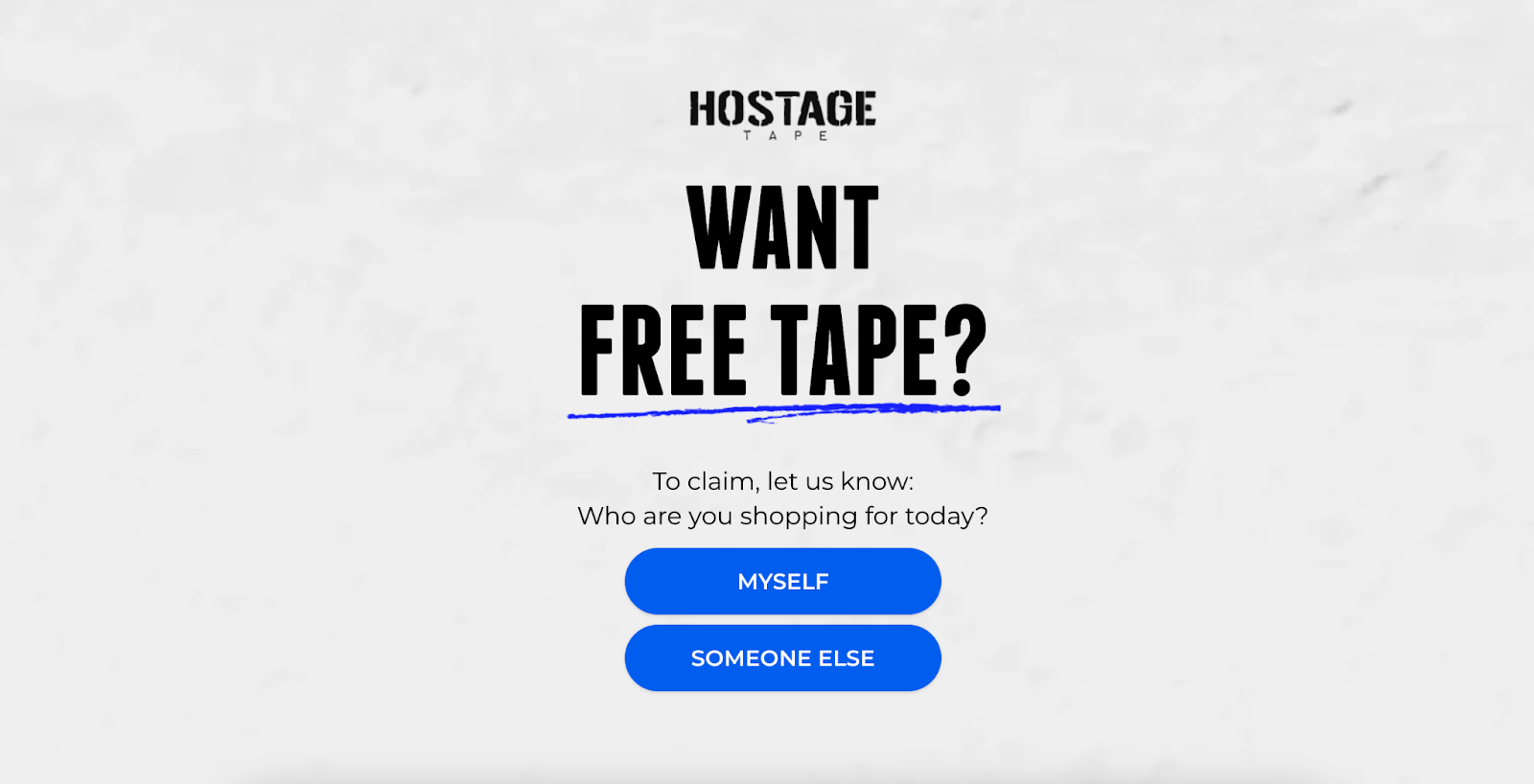
Hostage Tape, a sleep optimization brand, faced the challenge of converting high-traffic visitors into subscribers for their retention-focused business model. Their full-screen exit-intent approach captured attention at the critical departure moment.
The Exit-Intent Strategy:
- Full-screen, high-converting popups that immediately captured visitor attention
- Founder's story integration to build brand trust and engage departing users
- Hands-on A/B testing support for continuous iteration and improvement
- Exit-intent triggers combined with custom popup flows for maximum opt-ins
Results:
- 25% email opt-in rate achieved within two months
- 20% SMS opt-in rate
- 245% increase in email welcome flow revenue
- $86,000 in additional revenue from welcome flows in just two months
- 143x return on investment (ROI)
Example 15: Batch CBD's Intent-Based Exit Capture (36% Conversion)
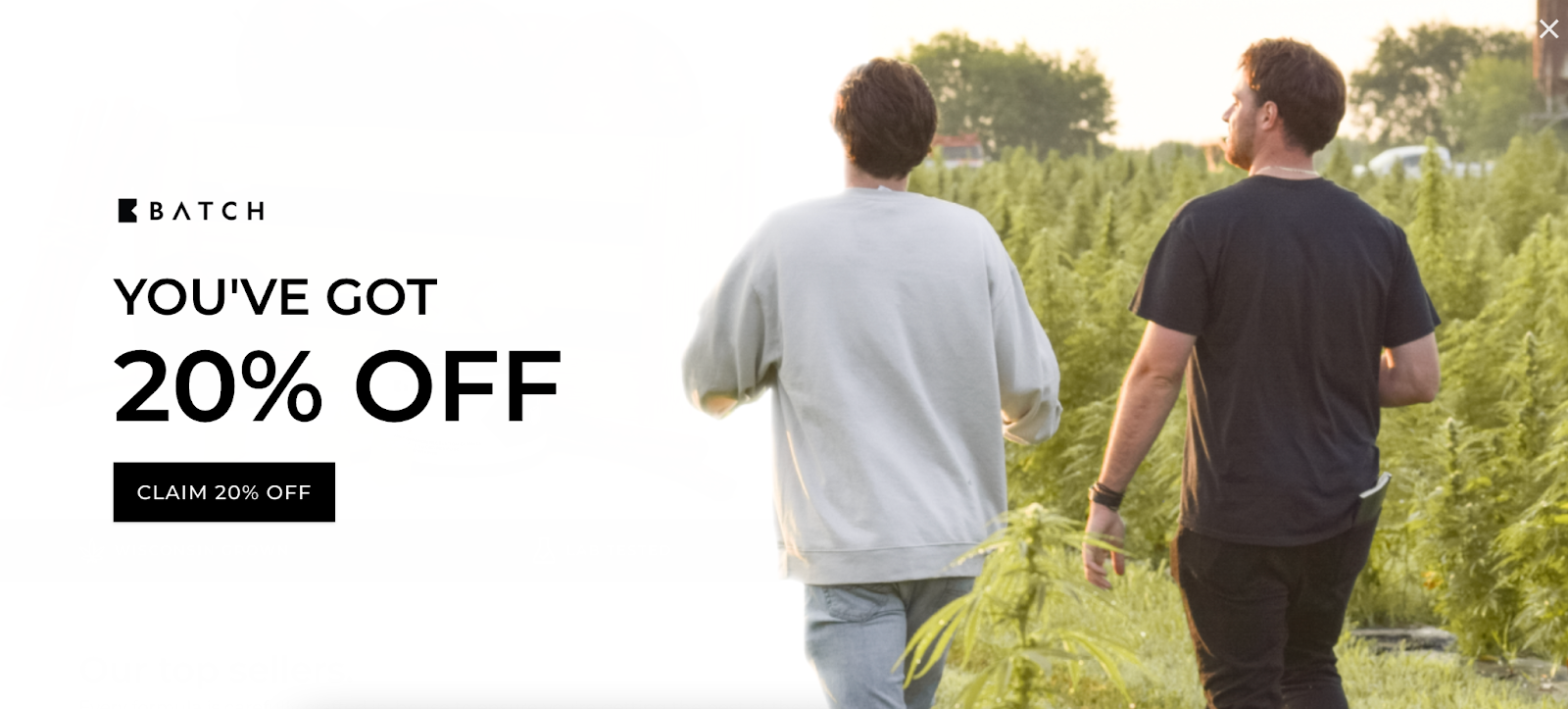
Batch CBD used exit-intent triggers to capture visitors who were leaving without understanding which products matched their specific needs (sleep, stress, mood, recovery).
The Intent-Based Approach:
- Two-step funnel approach for departing visitors
- Issue-based segmentation questions (sleep, stress, etc.) within exit popup
- Interactive exit-intent experience that felt helpful rather than pushy
- Real-time tracking and campaign optimization for continuous improvement
Results:
- 260% increase in email sign-ups
- 36% email opt-in rate (previously 10% with Klaviyo)
- 43% purchase rate after signup
- 25% increase in Black Friday sales compared to revenue projections
Industry-Specific Popup Examples
Different industries require different popup approaches. These examples show how successful brands adapt popup strategies to their specific industry requirements and customer expectations.
Example 16: Zero Foxtrot's Seasonal Scale Strategy (7.5% Conversion)
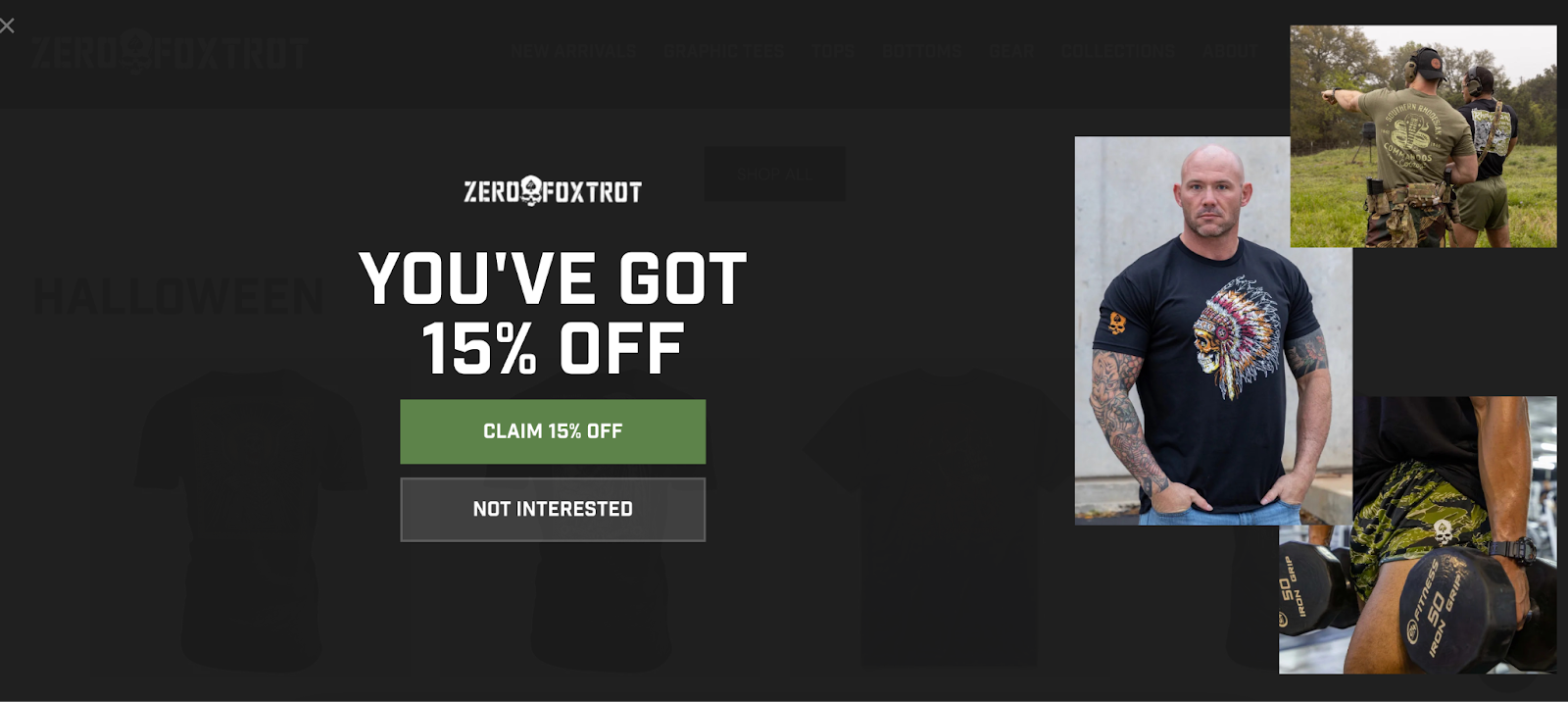
Zero Foxtrot, a veteran-founded apparel brand supporting first responders and military culture, needed a low-lift popup solution that could handle seasonal scale during Q4 while maintaining consistent email growth.
The Seasonal Strategy:
- Engaging, out-of-the-box popups optimized for high-converting leads
- Accurate coupon redemption and conversion tracking
- Consistent email growth during busiest sales periods
- Scalable acquisition strategy for seasonal surges
Results:
- Over 50,000 emails collected in under two months
- 32,000 email sign-ups in last 30 days
- $215,000 in attributed sales in 30 days
- 7.5% email sign-up rate (up from 3%)
- 20% purchase rate within 30 days of signup
Example 17: Manzuri's Two-Step Trust-Building Popup (40% Increase)
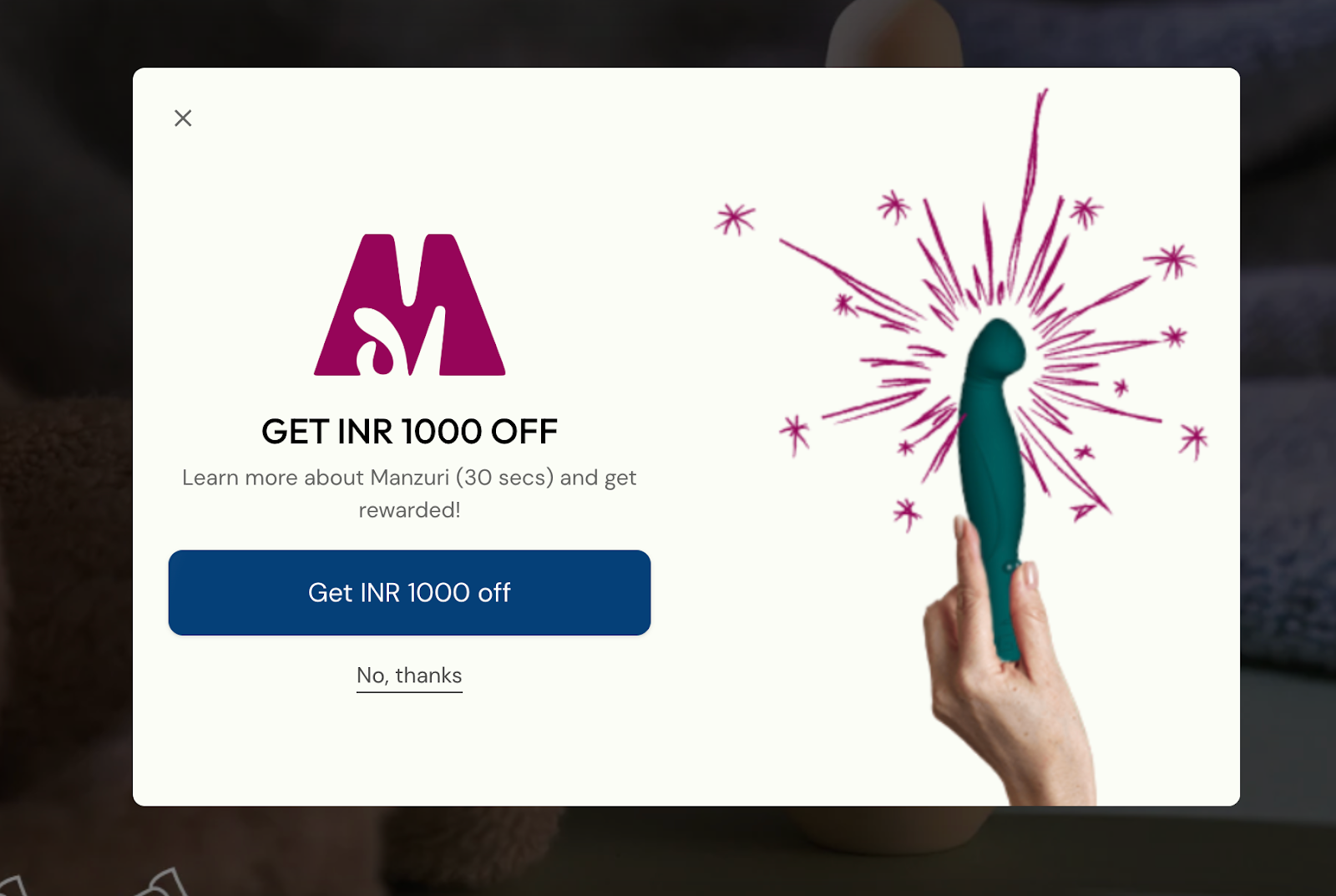
Manzuri, a modern sexual wellness brand in India, faced unique challenges around product education, safety concerns, and regional trust-building in a sensitive category requiring careful messaging and cultural sensitivity.
The Trust-Building Strategy:
- Two-step popup progression combining discounts with education
- FAQ integration addressing product use, safety, and legality concerns
- Regional trust-building elements specific to Indian market concerns
- Zero-party data collection for audience segmentation and targeting
Results:
- 40% increase in email sign-ups
- 20% increase in email-driven revenue
- 13% uplift in total annual revenue
- Higher conversion rates and improved subscriber quality
Example 18: Bibado's Product Education Popup (28% Conversion)
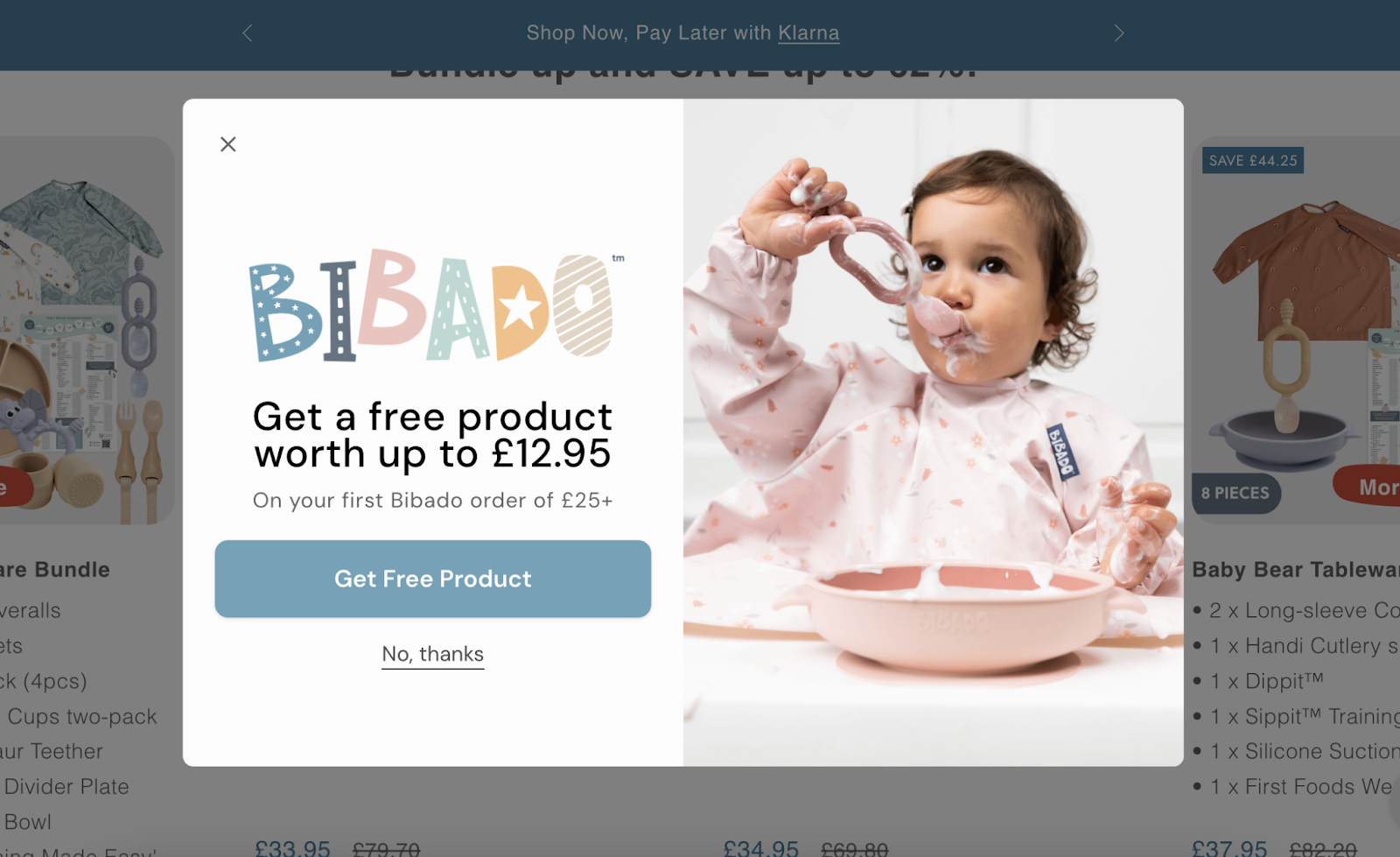
Bibado, a UK-based baby products brand specializing in award-winning mealtime products, needed to educate customers about the developmental benefits of their products while increasing average order value and customer lifetime value.
The Educational Strategy:
- Immersive popup flows telling brand and product stories
- Customer education during the signup experience
- Messaging variations and flow length testing
- Product bundling and cross-selling within popup flows
Results:
- 28% popup sign-up rate
- 30% purchase rate after signup
- 17% increase in average order value (AOV)
- 1,000+ customers educated weekly via Alia flows
Popup Performance Benchmarks & Metrics
Understanding what constitutes good popup performance helps set realistic expectations and identify optimization opportunities. Based on data from successful Shopify brands, here are the benchmarks you should aim for across different popup types and industries.
Performance Benchmarks by Popup Type:
Industry-Specific Benchmarks:
Common Popup Mistakes to Avoid
Even well-intentioned popup campaigns can fail due to common implementation mistakes. Learning from these frequent errors can save you time, money, and potentially damaging user experience issues.
Poor Timing and Triggering Mechanisms
Many popups appear too early (before the user has experienced enough of the site) or too late (after they've already decided to leave). Better approach: Set triggers based on engagement signals like 50-70% scroll depth, 30-60 seconds on page, or exit intent combined with behavioral indicators.
For example, MiHIGH was struggling with generic popups that delivered stagnant opt-in rates of just 6%. By switching to Alia's AI-powered smart triggering, which automates popup display timing based on user behavior, they achieved a 3x increase in opt-in rates and generated $600,000 in attributed sales in just 30 days.
Mobile Responsiveness Issues
Many popups are designed for desktop and poorly adapted for mobile, resulting in poor user experience on devices that account for 60%+ of traffic.
Mobile Optimization Checklist:
- Button size: Minimum 44x44 pixels for touch targets
- Form fields: Single email field only to reduce typing
- Popup size: Maximum 90% screen width with proper margins
- Loading speed: Under 2 seconds for popup appearance
- Touch spacing: Minimum 8px between interactive elements
Generic, Non-Personalized Messaging
Generic messaging fails to connect with specific visitor segments. Personalization strategies include page-specific messaging, traffic source customization, geographic personalization, and behavioral triggers for first-time vs. returning customers.
How to Implement These Popup Strategies
Seeing successful examples is just the first step—implementing these strategies effectively requires the right tools, setup process, and optimization approach. Here's your step-by-step guide to turning these examples into results for your own store.
Step 1: Audit Your Current Performance
Before implementing new strategies, establish baseline metrics:
- Current email capture rate across all traffic sources
- Traffic source analysis to identify which sources convert best
- Mobile vs. desktop performance gaps
- Page-specific performance variations
- Revenue attribution from email subscribers
Step 2: Choose Your Popup Strategy
Match your popup approach to your product complexity and audience awareness:
- Simple products - discount popups work well (fashion, accessories)
- Complex products - educational popups build trust (wellness, tech)
- High-consideration purchases - quiz/interactive popups guide decisions
- Repeat purchase products - focus on retention and loyalty messaging
Step 3: Design and Copy Creation
Create compelling popup elements using proven frameworks:
- Curiosity-driven headlines: "The Secret to [Desired Outcome]"
- Benefit-focused messaging: "Get [Specific Benefit] in [Timeframe]"
- Problem-solving approach: "Stop [Pain Point] with [Solution]"
- Social proof integration: "Join [Number] of [Target Audience] Who [Action]"
Step 4: Technical Setup and Integration
Configure your popup system for optimal performance:
- Time-based triggers: 45-60 seconds for engagement assessment
- Scroll-based triggers: 50-70% scroll depth for interest indication
- Exit-intent triggers: Mouse movement toward browser close/back
- Email marketing integration: Segmentation setup and welcome flow creation
Step 5: Testing and Optimization
Implement systematic testing for continuous improvement:
- Headlines and value propositions - biggest impact on conversion
- Offer types and amounts - discount percentage vs. fixed amount
- Visual design elements - colors, images, layout
- Timing and triggers - when and how popups appear
Need help with the technical setup? Our complete guide to adding popups on Shopify in under 10 minutes walks through the entire process step-by-step.
Ready to Scale with High-Converting Popups?
The most successful email popup examples share common elements: they provide clear value, respect user experience, and integrate seamlessly with the overall customer journey. Rather than interrupting the browsing experience, they enhance it by offering relevant solutions, education, or exclusive access that visitors actually want.
Your next steps:
- Audit your current popup performance against these benchmarks and identify improvement opportunities
- Choose 2-3 examples that align with your brand voice and customer expectations
- Implement systematic testing across headlines, offers, timing, and visual design
- Set up proper tracking to measure impact on both email growth and revenue attribution
- Plan for ongoing optimization based on performance data and customer feedback
Ready to implement these strategies? Alia makes it simple to create high-converting popups like the examples in this guide. With AI-powered optimization, Shopify-native integration, and templates based on real success stories, you can start seeing results within days, not months. See how brands achieve 25-35% conversion rates with Alia and get your 14-day free trial.


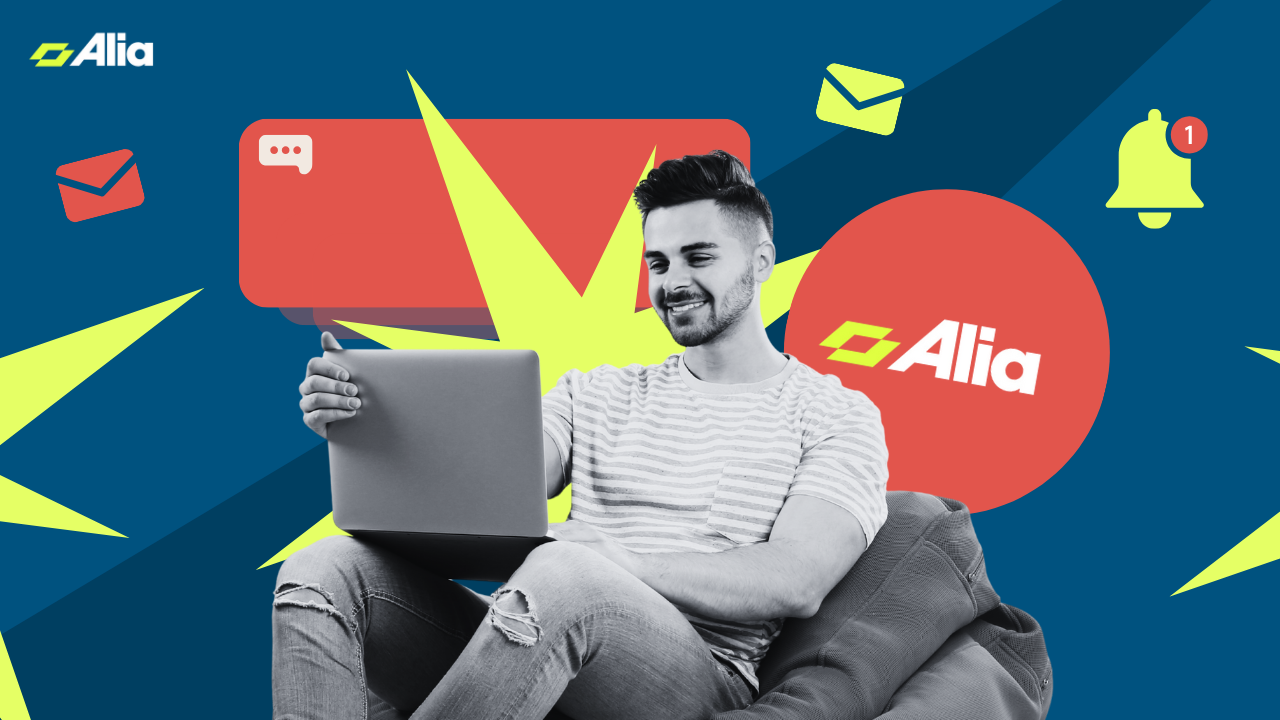

.png)













.webp)











































.webp)